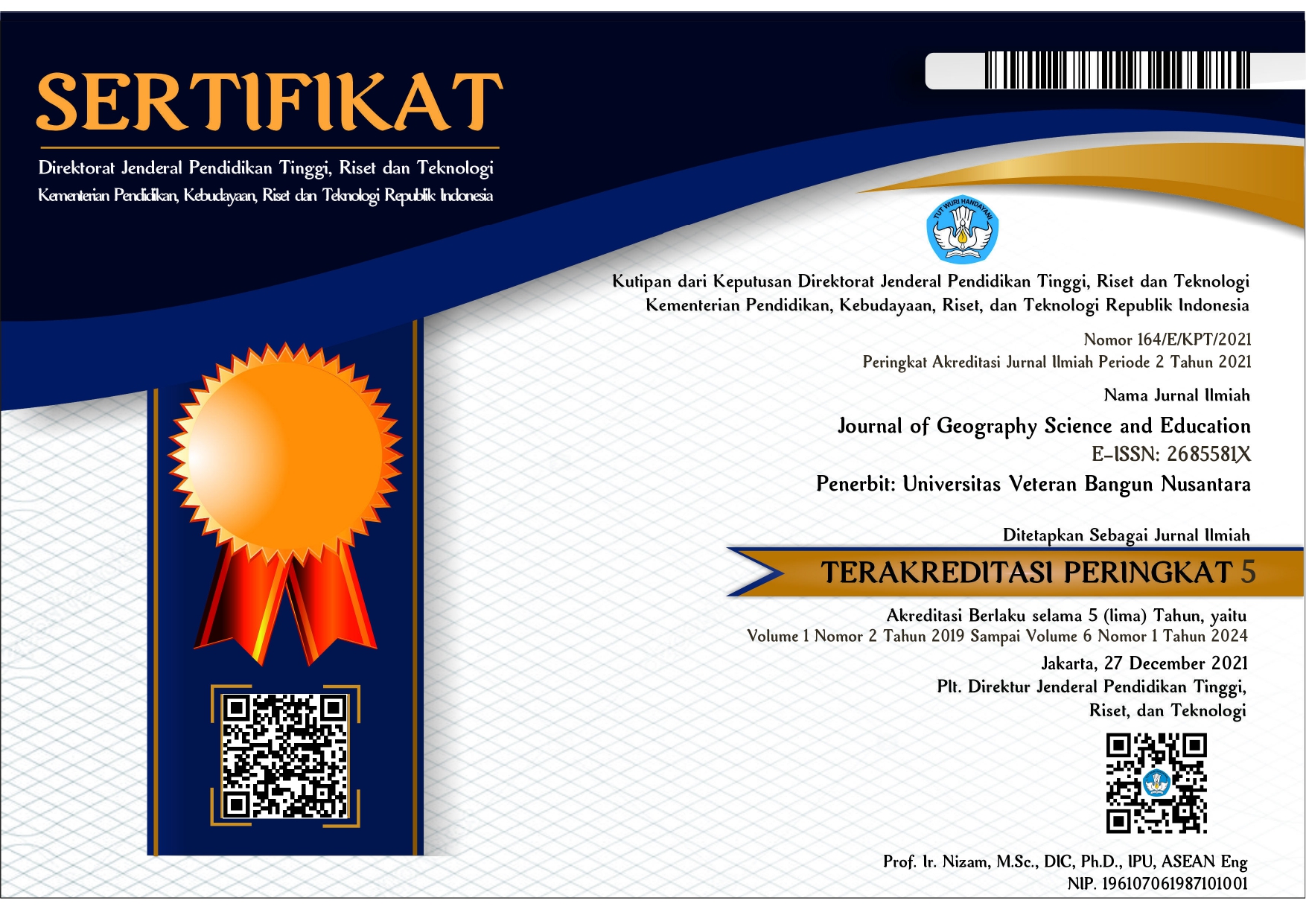THE DEVELOPMENT OF KIDOLAND TOURISM OBJECT IN PLESAN VILLAGE, NGUTER DISTRICT, SUKOHARJO DISTRICT
DOI:
https://doi.org/10.32585/jgse.v3i1.1516Kata Kunci:
Tourism Potential, SWOT analysis, Master PlanAbstrak
This research aims to: (1) analyze the tourism potential in Kidoland tourism objects, (2) investigate the changes in the tourism potential of Kidoland tourism objects after the development with a master plan.This study uses a qualitative descriptive method, which describes and describes tourism potential, as well as a SWOT analysis to determine the development strategy of tourism objects with a master plan design to determine changes in tourism potential. The data collection technique used was through field observations and documentation. Data analysis techniques are scoring and descriptive. The results of this study are: (1) The potential of the Kidoland tourism object in the observation, the value of 17.8 is obtained. Where the value of 17.8 is obtained from the per-variable calculation, namely the attractiveness with a value of 10, accessibility 3.6, and basic infrastructure and facilities with a value of 4.2. (2) To increase the tourism potential of Kidoland tourism objects, an object development plan is carried out with a master plan, namely the addition of facilities and infrastructure to the object, namely the addition of toilets, worship facilities, gazebo, electricity expansion and a garden. From the design of the master plan there is an increase in potential with numbers2.1. The initial potential with a total value of 17.8 becomes 19.9.
Unduhan
Referensi
Rosiyanti, A.W, Susilowati, D. 2017. Development of Tourism Objects in Bogor Regency.
Hamdani, A.F, Jamil, A.M.M. 2017. Utilization of Arcgis Online as a Media for Conveying Spatial Information in Malang City. 5 (1): 37- 41
Huda, Ahmad. 2015.Management of Cultural Heritage Tourism Object Facilities for the Tomb of the King of Kecik in Buantan Besar Village, Siak Regency.(2): 1- 15
Raharjo, et al. 2020. Development of Natural Tourism Objects and Attractions in Coban Srengenge as a Tourist Destination Area. 1 (2): 92-97
Delita, F, Elfayetti, Sidauruk, T. 2012, SWOT Analysis for the Development Strategy of the Mual Mata Bathing Tourism Object, Pematang Bandar District, Simalungun Regency. 9 (1): 41-52
[PHKA] Forest Protection and Nature Conservation. 2003 (A). Guidelines for Analysis of Areas of Operation of Objects and Natural Tourism Attractions (ADO-ODTWA), Directorate General of Forest Protection and Nature Conservation, Bogor.
Fandey, S.V. 2016. The Importance of Master Plan in Road Transportation Terminal Development Process. (Case Study: Ulu Terminal Master Plan in Sitaro Islands District). 4 (6): 391-397
Sugiyono.2014. Qualitative Research Methods, Quantitative And R & D. Bandung: Alfabeta, Cv.
Sutama. 2015. Quantitative Education Research Methods, Qualitative, CAR, R & D. Gumpang - Kartasura: Fairuz Media
Panjaitan, et al. 2015. Analysis of the Potential and Development Strategy of the Teroh Teroh Waterfall Natural Tourism Object, Rumah Galuh Village, Sei Bingai District, Langkat Regency, North Sumatra.
Unduhan
Diterbitkan
Cara Mengutip
Terbitan
Bagian
Lisensi
License and Copyright Agreement
In submitting the manuscript to the journal, the authors certify that:
- They are authorized by their co-authors to enter into these arrangements.
- The work described has not been formally published before, except in the form of an abstract or as part of a published lecture, review, thesis, or overlay journal. Please also carefully read JGSE's Posting Your Article Policy at http://pubs2.ascee.org/index.php/ijele/about/editorialPolicies#custom-5
- That it is not under consideration for publication elsewhere,
- That its publication has been approved by all the author(s) and by the responsible authorities – tacitly or explicitly – of the institutes where the work has been carried out.
- They secure the right to reproduce any material that has already been published or copyrighted elsewhere.
- They agree to the following license and copyright agreement.
Copyright
Authors who publish with Journal of Geography Science and Education agree to the following terms:
- Authors retain copyright and grant the journal right of first publication with the work simultaneously licensed under a Creative Commons Attribution License (CC BY-SA 4.0) that allows others to share the work with an acknowledgment of the work's authorship and initial publication in this journal.
- Authors are able to enter into separate, additional contractual arrangements for the non-exclusive distribution of the journal's published version of the work (e.g., post it to an institutional repository or publish it in a book), with an acknowledgment of its initial publication in this journal.
- Authors are permitted and encouraged to post their work online (e.g., in institutional repositories or on their website) prior to and during the submission process, as it can lead to productive exchanges, as well as earlier and greater citation of published work.
Licensing for Data Publication
Journal of Geography Science and Education use a variety of waivers and licenses, that are specifically designed for and appropriate for the treatment of data:
- Open Data Commons Attribution License, http://www.opendatacommons.org/licenses/by/1.0/ (default)
- Creative Commons CC-Zero Waiver, http://creativecommons.org/publicdomain/zero/1.0/
- Open Data Commons Public Domain Dedication and Licence, http://www.opendatacommons.org/licenses/pddl/1-0/
Other data publishing licenses may be allowed as exceptions (subject to approval by the editor on a case-by-case basis) and should be justified with a written statement from the author, which will be published with the article.
Open Data and Software Publishing and Sharing
The journal strives to maximize the replicability of the research published in it. Authors are thus required to share all data, code or protocols underlying the research reported in their articles. Exceptions are permitted but have to be justified in a written public statement accompanying the article.
The associated persistent identifiers (e.g. DOI, or others) of the dataset(s) must be included in the data or software resources section of the article. Reference(s) to datasets and software should also be included in the reference list of the article with DOIs (where available). Where no domain-specific data repository exists, authors should deposit their datasets in a general repository such as ZENODO, Dryad, Dataverse, or others.
Small data may also be published as data files or packages supplementary to a research article, however, the authors should prefer in all cases a deposition in data repositories.










